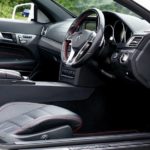Quick Navigation
After a day’s work, you hurriedly went home to have a delicious dinner. Suddenly, you are troubled to see your drive light blinking in your dashboard.

Without the knowledge to know what this means will lead you to more significant problems sooner.
Your dashboard lights are designed to alert you that something is wrong with your car. When these lights illuminate, it is critical to understand what your car is attempting to communicate and address it immediately.
But what does it mean when your D light keeps blinking? Let’s try to investigate some causes and solutions to this problem below.
Drive Light Blinking In Car – Causes And Solutions
Transmission Problem
A car’s transmission is a sensitive technology that needs frequent maintenance. If it does not undergo servicing, it will begin to have several difficulties that might result in its inability to shift.
It might leave you stuck, waiting for a tow vehicle, with a reasonably substantial repair cost coming your way.
If you are experiencing a blinking drive “D” light after shifting gears from reverse to drive in your car, you may have an issue with the transmission.
It seems problematic because it keeps blinking while it remains acceptable to operate. The check engine sign may also pop up with the blinking “D.”
It may indicate, otherwise, a mechanical problem in the transmission system.
Solution
If you have a drive light blinking problem, it is suggested and recommended not to drive your vehicle any further because it may damage your car’s transmission system.
Moreover, it is ideal to stop and have your car looked at by a reputable mechanic nearby to solve the problem.
If you want to do it yourself, get a cheap OBDII scanner and get the codes to know the cause of the blinking.
Low Transmission Fluid
One of the common causes of drive light blinking in cars is having a low transmission fluid.
Whenever you notice that your drive light is flashing in your dashboard and you hear a grinding noise that frequently occurs during shifting, that is a sign that your car lacks transmission fluid.
Solution
Inspecting the transmission fluid will be the first thing you do whenever you experience driving with a drive light blinking in a car.
Shift your gears to neutral and park your brakes on while letting your engine run idle. With that, you can check your transmission fluid by wiping the dipstick with a clean rag.
If you find out that it contains low transmission fluid than average, all you’ve got to do is drain and refill in some more to remove the issue.
Run the car and go to each gear to check if the issue has been solved.
Remember that whenever you hear unknown noises in your car, it is vital that you check it in the auto shop or your trusted mechanic. In that way, you will be safe and be saving time also.
Overheating Transmission Fluid
Another cause of drive light blinking in cars is associated with overheating transmission fluid.
If you noticed a burning smell after you noticed the blinking “D” light, that means that your transmission fluid is overheating.
It will cause friction problems with the moving parts in your car’s transmission system.
It will probably occur if you drive 65 MPH or more or drive at an ambient temperature of 96 degrees and higher.
Climbing steep hills for a long duration may also overheat the transmission fluid, making your drive light indicator blink.
Solution
Park your car in a safe location but leave the engine running. Select the Park position on the selector lever and open the hood.
Maintain your car’s engine idle. Next, adjust the selection lever to a position other than Park and check whether the drive light stops flashing.
Whenever it comes to a halt, you may continue driving since it is deemed safe.
However, if the indicator still blinks intermittently, have your transmission fluid inspected and replaced in the nearest auto shop as soon as possible.

Faulty Transmission Speed Sensor Or Electric Load Detector
Often, water could go into your transmission speed sensor and result in a drive light blinking in the car. Or it might be that your electric load detector is faulty.
Electric load detectors are the ones that drive the load from the electric system. It is the component that keeps the battery charged.
If you also noticed a change in the car’s transmission, such as transmission revolutions are higher than before, or your car’s transmission goes into overdrive late or experiencing hard brakes that usual while seeing that blinking light, then your most probably have a faulty transmission speed sensor.
Solutions
If you have found out that your electric load detector is faulty, the cause could be is that it might not be putting enough load in the system to let the electrical components work properly.
With that, you should inspect and keep your grounds clean for it may generate bad electrical problems.
Transmission Fluid Leak
If you see a crimson red fluid dripping from your vehicle after seeing the flashing drive light indicator in your dashboard, you have most likely uncovered a transmission fluid leak.
Low fluid levels may cause severe damage to the gearbox, which will almost certainly need rebuilding or replacing.
A leak in your transmission system will permanently risk and damage your car if you continue to drive with low transmission fluid levels.
That will lead to extensive and expensive repairs and replacements, depending on the extent of the damage.
Solution
If you find anything oozing from your car, immediately take it to an auto shop to get it fixed.
High-Pressured Or Faulty Clutch Pressure Solenoid
In a car’s system, the clutch pressure solenoid is the one that is on the top of your transmission. It will prevent the pressure from activating the desired gear.
It makes everything running in the car, such as rough shifts and blinking lights.
If you see a check engine light accompanied with the drive light blinking or erratic shifting and problems in shifting gears, then a faulty shift solenoid might be the culprit.
Solution
A thorough cleaning of the transmission system may fix this issue. Remove the valves and clean them, as well as the screen.
After cleaning, listen to it again if it persists. If not, then check if the drive light is still blinking.
You may also consider replacing the linear solenoid. It will surely do the trick to fix the drive light blinking in the car.
Torque Converter Issues
A faulty torque converter may cause transmission damage. Numerous torque converter failures are caused by high friction, which results in damage to the torque converter’s needle bearings.
Additionally, broken seals or a malfunctioning clutch solenoid might be at fault. A defective seal might cause liquids to escape and harm the environment.
Solution
When you observe that you have contaminated transmission fluid, don’t panic. Instead, go to your nearest auto shop or your trusted mechanic friend to drain and replace it with a new one.
Final Thoughts
Early detection of problems may need a minor adjustment, a simple electrical repair, or fluid maintenance.
If all of the suggested manual procedure fails, you can go with the technological step by scanning codes for errors.
Scanning may expedite the process and provide valuable information about the nature of the issue, its location, and what you should examine first.
Keep an eye out for these transmission issue signals and, if you encounter any, call a professional transmission repair center immediately.

James has been a car enthusiast since his childhood when he learned the differences between a ford and a chevy from his father. He loves to drive and restore old cars with a special drive for Italian marvels. Currently, he has a 1968 Alfa Romeo. He has studied aeronautics and civil aviation in his college and still gets smitten by Galant SS and Lancer GSR.
He is a New York-based product training director working with a giant automotive retailer. He loves to review and uncover the vehicles and their fascinating stories. He believes in keeping it legitimate with a keen passion for research on the latest technological upgrades in cars. While reading his articles or blogs, you can sense the extensive research and dedication backing the piece of text. He loves fried chicken, music, and spending quality time with his pet dog.






